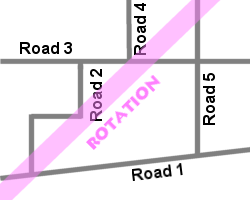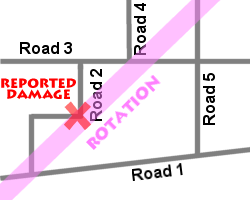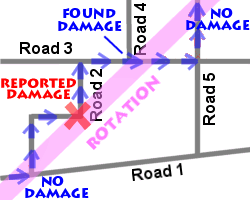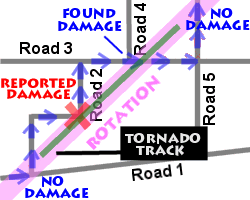 |
| For Your Information |
| If there is something that may be of interest to you, we will try to make that information available. |
|
|
 |
About Damage Surveys |
 |
| |
| Surveying tornado damage can be a tedious process, especially if there are a lot of tracks to cover, or a long track. Following a large outbreak of severe weather, surveys can last for days. |
 |
To aid surveyors in finding a tornado track, archived radar data is analyzed before the survey begins. Areas of rotation (where tornadoes may have been spawned by storms) are plotted on a map (or in GPS software) to give surveyors a target area. |
| Next, damage reports (from trained spotters, emergency managers, law enforcement, the media, the public, etc) are considered. The reports are connected with areas of rotation (from archived radar data) to give surveyors a starting point. |
 |
 |
The survey now begins. Note that it may take two or more hours to reach the affected location. Once surveyors arrive, they navigate roads through the reported damage and follow where rotation occurred. |
|
|
| In the picture: Damage surveys take a lot of time, as explained by Rick Smith (Warning Coordination Meteorologist at the National Weather Service in Norman, OK) via Twitter. |
|
| |
|
If the storm moved from southwest to northeast, the surveyors will cover areas to the southwest and northeast of the reported damage in an effort to find the starting and ending points of the tornado track.
|
| When following a track, damage will often be found in addition to what was reported. When there is no more damage noted (to the northeast and southwest of the original damage), the completed tornado track is plotted. The tornado is given a rating (EF0, EF1, EF2, etc), a path width (in yards), and a length (in miles). |
 |
|
At times, damage surveys are performed from the air. The National Weather Service in Little Rock has flown with the Civil Air Patrol on several occasions. An aerial survey was necessary following a long track tornado (122 miles) through northern Arkansas on February 5, 2008. Without the survey, it was uncertain if the track was continuous through rugged terrain not accessible by vehicles.
Surveys tend to go more quickly from the air than on the road, but smaller tornado tracks are sometimes difficult to see from above, and fine details can be missed. Since most tornadoes tend to be small/weak, the majority of surveys remain on the ground.
Eventually, results from surveys become available in "Storm Data", a monthly publication produced by the National Centers for Environmental Information (NCEI) in Asheville, NC.
|
|
|